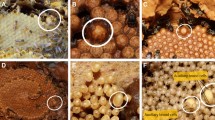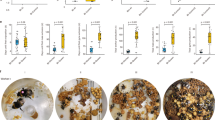Abstract
The death of the queen can lead to behavioral changes in workers of eusocial bees that alter their longevity. Here, we investigated the behavior and longevity of workers in colonies of the neotropical stingless bee Scaptotrigona aff. postica in the absence of a mated queen. Eight colonies, four being queenright, and four with their physogastric queens removed (queenless), were used in experiments. Emerging workers were marked with different colors to obtain age cohorts. We observed external foraging activity, age of workers involved in cell construction and foraging, and worker longevity in all colonies for 100 days. Over time, queenless colonies presented a greater reduction in external activity than queenright colonies; older workers were more frequently observed participating in cell construction and foraging compared with queenright colonies, and worker lifespan in queenless colonies was about a third longer than that observed in queenright colonies. Our study demonstrates that orphaned workers of this species substantially alter their behavior, causing an increase in their overall longevity and workers starting to lay haploid eggs, allowing some direct reproduction by workers in the absence of a queen.
Significance statement
For eusocial species, the loss of the reproductive individual is a critical period for colony survival. Our study shows, for the first time, how workers in a neotropical stingless bee species adapt their behavior during periods without a queen. We show that the longevity of workers of Scaptotrigona aff. postica from orphaned colonies on average increased by 33% compared with regular colonies. We also show that many foragers from orphaned colonies spend more time inside the nest building brood cells rather than participating in more risky foraging behaviors. Therefore, workers alter their behavior in the absence of an egg-laying queen; these changes cause a substantial increase of longevity of the labor force (i.e., workers), and consequently, a possibility that the nest survives until a new mated queen resumes oviposition. In case a new queen does not appear in the colony, males produced by egg-laying workers (which gain a direct fitness through direct reproduction) may spread the colonial genome, by mating with queens from other colonies.





Similar content being viewed by others
Data availability
The datasets generated during and/or analyzed during the current study are available from the corresponding author on reasonable request.
References
Alves DA, Imperatriz-Fonseca VL, Francoy TM, Santos-Filho PS, Nogueira-Neto P, Billen J, Wenseleers T (2009) The queen is dead–long live the workers: intraspecific parasitism by workers in the stingless bee Melipona scutellaris. Mol Ecol 18:4102–4111
Amdam GV, Simões ZLP, Hagena A, Norberg K, Schrøder K, Mikkelsen Ø, Kirkwood TBL, Omholt SW (2004) Hormonal control of the yolk precursor vitellogenin regulates immune function and longevity in honeybees. Exp Gerontol 39:767–773
Bego LR (1982) On social regulation in Nannotrigona (Scaptotrigona) postica Latreille, with special reference to male production cycles (Hymenoptera, Apidae, Meliponinae). Bol Zool Univ São Paulo 7:181–196
Beshers SN, Huang ZY, Oono Y, Robinson GE (2001) Social inhibition and the regulation of temporal polyethism in honey bees. J Theor Biol 213:461–479
Blacher P, Huggins TJ, Bourke AFG (2017) Evolution of ageing, costs of reproduction and the fecundity–longevity trade-off in eusocial insects. Proc R Soc B 284:20170380
Campbell AJ, Gomes RLC, da Silva KC, Contrera FAL (2019) Temporal variation in homing ability of the neotropical stingless bee Scaptotrigona aff. postica (Hymenoptera: Apidae: Meliponini). Apidologie 50(5):720–732
Crespi BJ (1994) The definition of eusociality. Behav Psychol 6:109–115
Cruz-Landin C (2000) Ovarian development in Meliponine bees (Hymenoptera: Apidae): the effect of queen presence and food on worker ovary development and egg production. Genet Mol Biol 23(1):83–88
Dallacqua RP, Simões ZLP, Bitondi MMG (2007) Vitellogenin gene expression in stingless bee workers differing in egg-laying behavior. Insect Soc 50:70–76
Dammann P, Sumbera R, Maßmann C, Scherag A, Burda H (2011) Extended longevity of reproductives appears to be common in Fukomys mole-rats (Rodentia, Bathyergidae). PLoS One 6(4):e18757
Dixon L, Kuster R, Rueppell O (2014) Reproduction, social behavior, and aging trajectories in honeybee workers. Age 36:89–101
Fluri P, Wille H, Gerig L, Lüscher M (1977) Juvenile hormone, vitellogenin and haemocyte composition in winter worker honeybees (Apis mellifera). Experientia 33(9):1240–1241
Gomes RLC, Menezes C, Contrera FAL (2015) Worker longevity in an Amazonian Melipona (Apidae, Meliponini) species: effects of season and age at foraging onset. Apidologie 46:133–143
Hartfelder K, Makert GR, Judice CC, Pereira GAG, Santana WC, Dallacqua R, Bitondi MMG (2006) Physiological and genetic mechanisms underlying caste development, reproduction and division of labor in stingless bees. Apidologie 37(2):144–163
Imperatriz-Fonseca VL, Oliveira MAC (1976) Observations on a queenless colony of Plebeia saiqui (Friese) (Hymenoptera, Apidae, Meliponinae). Bolm Zool Univ São Paulo 1:299–312
Jandt JM, Dornhaus A (2011) Competition and cooperation: bumblebee spatial organization and division of labor may affect worker reproduction late in life. Behav Ecol Sociobiol 65:2341–2349
Johnson BR (2008) Within-nest temporal polyethism in the honey bee. Behav Ecol Sociobiol 62:777–784
Johnson BR (2010) Division of labor in honeybees: form, function, and proximate mechanisms. Behav Ecol Sociobiol 64:305–316
Katayma E (1996) Survivorship curve and longevity for workers of Bombus ardens Smith and Bombus diversus Smith (Hymenoptera, Apidae). Jpn J Ent 64(1):111–121
Khoury DS, Myerscough MR, Barron AB (2011) A quantitative model of honey bee colony population dynamics. PLoS One 6(4):e18491
Kleinert AMP (2005) Colony strength and queen replacement in Melipona marginata (Apidae: Meliponini). Braz J Biol 65(3):469–476
Koedam D, Contrera FAL, Fidalgo AO, Imperatriz-Fonseca VL (2005) How queen and workers share in male production in the stingless bee Melipona subnitida Ducke (Apidae, Meliponini). Insect Soc 52:114–121
Kuszewska K, Miler K, Rojek W, Woyciechowski M (2017) Honeybee workers with higher reproductive potential live longer lives. Exp Gerontol 98:8–12
Le Conte Y, Hefetz A (2008) Primer pheromones in social Hymenoptera. Annu Rev Entomol 53:523–542
Leão KL, Queiroz ACM, Veiga JC, Contrera FAL, Venturieri GC (2016) Colony development and management of the stingless bee Scaptotrigona aff. postica (Apidae: Meliponini) using different hive models. Sociobiol 63(4):1038–1045
Luz GF, Campos LAC, Zanuncio JC, Serrão JE (2017) Auxiliary brood cell construction in nests of the stingless bee Plebeia lucii (Apidae: Meliponini). Apidologie 48:781–691
de Moraes BC, da Costa JMN, da Costa ACL, Costa MH (2005) Variação espacial e temporal da precipitação no Estado do Pará. Acta Amaz 35:207–214
Moritz FRA, Fuchs S (1998) Organization of honeybee colonies: characteristics and consequences of a superorganism concept. Apidologie 29:7–21
Münch D, Amdam GV (2010) The curious case of aging plasticity in honey bees. FEBS Lett 584:2496–2503
Nunes TM, Oldroyd BP, Elias LG, Mateus S, Turatti IC, Lopes NP (2017) Evolution of queen cuticular hydrocarbons and worker reproduction in stingless bees. Nat Ecol Evol 1:0185
Nunes-Silva P, Hilário SD, Filho PSS, Imperatriz-Fonseca VL (2010) Foraging activity in Plebeia remota, a stingless bee species, is influenced by the reproductive state of a colony. Psyche 2010:241204
Oystaeyen AV, Alves DA, Oliveira RC, Nascimento DL, Nascimento FS, Billen J, Wenseleers T (2013) Sneaky queens in Melipona bees selectively detect and infiltrate queenless colonies. Anim Behav:1–7
Page RE Jr, Peng CYS (2001) Aging and development in social insects with emphasis on the honey bee, Apis mellifera L. Exp Gerontol 36:695–711
Paxton RJ, Bego LR, Shah MM, Mateus S (2003) Low mating frequency of queens in the stingless bee Scaptotrigona postica and worker maternity of males. Behav Ecol Sociobiol 53:174–181
Pinheiro J, Bates D, DebRoy S, Sarkar D, R Development Core Team R (2015) nlme: linear and nonlinear mixed effects models. R package version 3. 1–122. https://CRAN.R-project.org/package=nlme
Pinho OC, Manente-Balestieri FCL, Balestieri JBP (2010) Respostas de colônias de Plebeia catamarcensis Holmberg (Hymenoptera, Apidae, Meliponina) à orfandade. Rev Bras Bioc 8:201–207
Queiroz ACM, Leão KL, Teixeira JCS, Contrera FAL, Menezes C (2019) Stingless bees fed on fermented soybean-extract-based diet had reduced lifespan than pollen-fed workers. Sociobiol 66:107–112
R Core Team (2016) R: a language and environment for statistical computing. R Foundation for Statistical Computing, Vienna, https://www.R-project.org/. Accessed 22 Jan 2020
Ratnieks FLW (1993) Egg-laying, egg-removal, and ovary development by workers in queenright honey bee colonies. Behav Ecol Sociobiol 32:191–198
Ratnieks FLW, Reeve HK (1992) Conflict in single-queen hymenopteran societies: the structure of conflict and processes that reduce conflict in advanced eusocial species. J Theor Biol 158:33–65
Ribeiro MF, Wenseleers T, Santos Filho PS, Alves DA (2006) Miniature queens in stingless bees: basic facts and evolutionary hypotheses. Apidologie 37:191–206
Roth KM, Beekman M, Allsopp MH, Goudie F, Wossler TC, Oldroyd BP (2014) Cheating workers with large activated ovaries avoid risky foraging. Behav Ecol 25(3):668–674
Roubik DW (1982) Seasonality in colony food storage, brood production and adult survivorship: studies of Melipona in tropical forest (Hymenoptera: Apidae). J Kansas Entomol Soc 55(4):789–800
Rueppell O, Bachelier C, Fondrk MK, Page RE Jr (2007) Regulation of life history determines lifespan of worker honey bees (Apis mellifera L.). Exp Gerontol 42:1020–1032
Sakagami SF (1982) Stingless bees. In: Hermann HR (ed) Social insects. Academic Press, New York, pp 316–423
Sakagami SF, Fukuda H (1968) Life tables for worker honeybee. Res Popul Ecol 10:127–139
Tan K, Wang Y, Dong S, Liu X, Zhuang D, Chen W, Oldroyd BP (2015) Associations between reproduction and work in workers of the Asian hive bee Apis cerana. J Insect Physiol 82:33–37
Therneau T (2015) A package for survival analysis in S_. version 2.38, <URL: https://CRAN.R-project.org/package=survival>. Accessed 22 Jan 2020
Tóth E, Strassmann JE, Nogueira-Neto P, Imperatriz-Fonseca VL, Queller DC (2002) Male production in stingless bees: variable outcomes of queen-worker conflict. Mol Ecol 11:2661–2667
Tóth E, Queller DC, Dollin A, Strassmann JE (2004) Conflict over male parentage in stingless bees. Insect Soc 51:1–11
Veiga JC, Menezes C, Contrera FAL (2017) Insights into the role of age and social interactions on the sexual attractiveness of queens in an eusocial bee, Melipona flavolineata (Apidae, Meliponini). Sci Nat 104:31
Veiga JC, Leão KL, Coelho BW, Queiroz ACM, Menezes C, Contrera FAL (2018) The life histories of the “uruçu amarela” males (Melipona flavolineata, Apidae, Meliponini). Sociobiol 65(4):780–783
Visscher PK, Dukas R (1997) Survivorship of foraging honey bees. Insect Soc 44:1–5
Wickham H (2009) ggplot2: elegant graphics for data analysis. Springer-Verlag, New York
Woyciechowski M, Kuszewska K (2012) Swarming generates rebel workers in honeybees. Curr Biol 22:707–711
Acknowledgments
We thank Embrapa Amazônia Oriental for the available infrastructure, to Dr. Cristiano Menezes (Embrapa Amazônia Oriental) for providing us the Scaptotrigona colonies, and to MSc Ana Carolina Martins de Queiroz, Dr. Jamille Costa Veiga, and Dr. Kamila Leão Leão for the assistance during the experiment. We also thank two anonymous referees that helped us to improve the quality of the manuscript.
Funding
This work was supported by the Coordenação de Aperfeiçoamento de Pessoal de Nível Superior (CAPES), which supported BSCL by a MSc grant. AJC was supported by two postdoctoral grants from CNPq (300037/2018-0) and CAPES/EMBRAPA (process 15/2014).
Author information
Authors and Affiliations
Contributions
BSCL and FALC conceived the experiments, BSCL performed the experiments, BSCL and AJC analyzed the data, and all the authors wrote the manuscript. All the authors have read and approved the submitted manuscript.
Corresponding author
Ethics declarations
Ethical approval
All applicable international, national, and/or institutional guidelines for the care and use of animals were followed.
Additional information
Communicated by O. Rueppell
Publisher’s note
Springer Nature remains neutral with regard to jurisdictional claims in published maps and institutional affiliations.
Rights and permissions
About this article
Cite this article
dos Santos Conceição Lopes, B., Campbell, A.J. & Contrera, F.A.L. Queen loss changes behavior and increases longevity in a stingless bee. Behav Ecol Sociobiol 74, 35 (2020). https://doi.org/10.1007/s00265-020-2811-8
Received:
Revised:
Accepted:
Published:
DOI: https://doi.org/10.1007/s00265-020-2811-8




